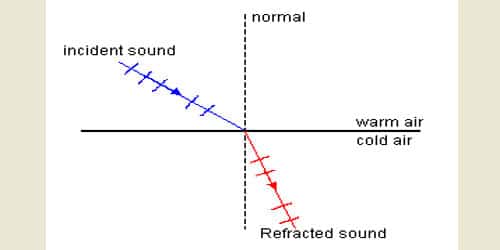Refraction has many applications in optics and technology. A lens uses refraction to form an image of an object for many different purposes, such as magnification. A prism uses refraction to form a spectrum of colors from an incident beam of light. Refraction also plays an important role in the formation of a mirage and other optical illusions.
Reflection of sound is based on the two laws and they are:
- The incidence angle is always equal to the reflection angle.
- The incident sound wave, the normal, and the reflected wave, all rest in a common plane.
It is easier to hear the sound during the night than during the day-time.
During day time, the upper layers of air are cooler than the layers of air near the surface of the Earth. During the night, the layers of air near the Earth are cooler than the upper layers of air. As sound travels faster in hot air, during day-time, the sound waves will be refracted upwards and travel a short distance on the surface of the Earth. On the other hand, during the night the sound waves are refracted downwards to the Earth and will travel a long distance.
The refraction of a sound wave can change speed and direction, for example – light traveling from air into water.
Following are the practical applications of reflection of sound waves are:
- Reflection of sound is used to measure the distance and speed of underwater objects. This method is known as SONAR.
- Working with a stethoscope is also based on the reflection of sound. In a stethoscope, the sound of the patient’s heartbeat reaches the doctor’s ear by multiple reflections of sound.
- The working of hearing aid is based on the reflection of sound. In hearing aid the sound waves are reflected in a slimmer area so as to direct the sound to the ear.
- The soundboard is based on the reflection of sound. Here, the sound waves are uniformly reflected can be seen in the auditorium. This helps in improving quality.












